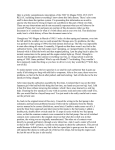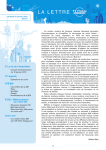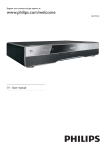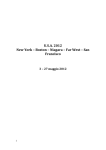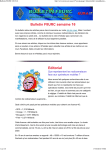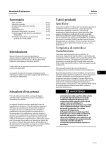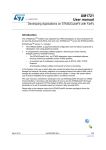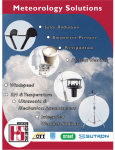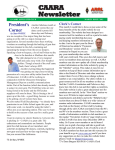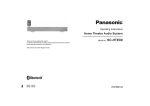Download March 2010 - Dixie Amateur Radio Club
Transcript
'L[LH$PDWHXU5DGLR&OXE
0DUFK
3DJH
:KR$UH
:H"
0DUFK
9ROXPH,VVXH
2010 Dixie Amateur Radio Club
0DUFK0HHWLQJ3UHYLHZ
0$56DQGKRZ\RXFDQEHLQYROYHG
How many amateurs know what MARS is? No, we’re
not talking about the place that the little green man in
the Loony Tunes cartoon came from, threatening to
blow up the Earth with his Illudium Q-36 Explosive
Space Modulator.
7KH 'L[LH $PDWHXU 5DGLR
&OXE ,QFLV DQRQSURILW ,56
F DVVRFLDWLRQ RI
IHGHUDOO\ OLFHQVHG $PDWHXU
5DGLRRSHUDWRUVDOVRNQRZQ
DV KDP UDGLR RSHUDWRUV
ZKR SULPDULO\ UHVLGH LQ
VRXWKZHVWHUQ 8WDK PRVWO\
LQWKHJUHDWHU6W*HRUJH&LW\
PHWURSROLWDQ DUHD :H DOVR
KDYH PHPEHUV ZKR OLYH LQ
UXUDO DUHDV RI :DVKLQJWRQ
MARS used to be known as the Military Amateur Radio
Service or Military Affiliated Radio Service. Recently, to
better fit their mission, they changed the name to the Military
Auxiliary Radio Service.
&RXQW\ DQGLQ DUHDVRXWVLGH
Steve Peterson, KI7L, will present information on the new
MARS at the March 17th meeting. Operational changes and
membership information will be provided.
/HDJXH$55/7KH1DWLRQDO
Also information on new 12V DC Power Distribution devices
will be shown. All in all, a meeting you don’t want to miss!
Take time to enjoy Amateur Radio.
7DEOHRI
&RQWHQWV
RI WKH FRXQW\ 7KH 'L[LH
$PDWHXU5DGLR&OXE,QFLVD
IRUPDOO\$IILOLDWHG&OXEZLWK
WKH $PHULFDQ 5DGLR 5HOD\
)HEUXDU\0HHWLQJ
$VVRFLDWLRQ IRU $PDWHXU
5DGLR
President’s Corner...........2
New Ham Class...............2
Coaxial Cable..................3
Farwell and Good............4
The February meeting was, in the words of one at- K7DLX’s Word Search.....5
tendee, “the best and most interesting club meeting I’ve Contest Calendar.............5
ever attended!”
Forshee’s Corner.............6
Radio Geezer?.................6
Kevin Barjenbruch of the National Weather Service The Rettysnitch................9
6WRUPZDWFKHUV
enlightened us with instruction and tips on Stormwatching, and how we as amateur radio operators can help
the NWS with observations. Our observations can tip
the balance in whether an alert is issued for a particular
area for high rainfall, flooding, or even tornadoes.
In other happenings, President Nick Nickle, W7CRN gave a synopsis of the bylaw change
which will be voted on at the March meeting, and Vice-President Kory Talbot KE7MMH told us
about the use of a storage unit which has been donated to the
Club. If you have Club property please contact Kory to see if it
should be stored in the unit.
The handouts Kevin provided will be available at the Welcome
table at the March club meeting for reading, should you wish to
see them. Many thanks to Kevin for the fascinating presentation - and to all the club members and others who attended this
meeting.
,W
VQRWWKHFODVVRI
WKHOLFHQVHWKDWWKH
$PDWHXUKROGVEXW
WKH&ODVVRIWKH
$PDWHXUWKDWKROGV
WKH/LFHQVH
'L[LH$PDWHXU5DGLR&OXE
%RDUG0HPEHUV
3UHVLGHQW&5´1LFNµ1LFNOH:&51
9LFH3UHVLGHQW.RU\7DOERW.(00+
6HFUHWDU\.HYLQ0HUULOO.(7/:
7UHDVXUHU+DUROG:HOOV.(2=*
%RDUG0HPEHU6FRWW7D\ORU.(<,4
%RDUG0HPEHU%UXFH%LVVHOO.(/*'
%RDUG0HPEHU.HQ)RUVKHH.('=,
3DVW3UHVLGHQWV
RI'$5&
.HQ)RUVKHH.('=,
5LF:D\PDQ.'/;
+DO:KLWLQJ.,8
+DO:KLWLQJ.,8
*DU\=DEULVNLH1$5(
'DQ)DUZHOO:(4$
'DQ)DUZHOO:(4$
5RQ6DSSLQJWRQ:,=
7UDYLV/RIWKRXVH.')51
&DQDQ\RQHKHOSPHFRPSOHWHWKLVOLVW"
3OHDVHFRQWDFW5LF:D\PDQDW
NGO[KDP#JPDLOFRP
68%0,66,216:$17('
6HQG\RXULGHDVELRVDUWLFOHVFDUWRRQVHWF
WR5LF:D\PDQDWNGO[KDP#JPDLOFRP
$//+(/3:,//%($335(&,$7('
0DUFK
1LFN1LFNOH:&51
3DJH
3UHVLGHQW·V
&RUQHU
The March Board of Directors meeting will be held on
Thursday, March 4th at 7:00 PM in room E of the
Community Arts Building, 86 South Main Street in St
George. All members are welcome to attend.
At our March Club meeting on Wednesday March
17th, a vote will be held on the proposed changes to
the Bylaws: a) change term of membership from
calendar year to 12 consecutive months; b) change to
consider honorary members full members for all purposes of the DARC; and c) change to provide designation of a chairperson for committees at the discretion of the Board of
Directors. To vote you must be a full member in good standing (2010 dues paid).
We will also have a presentation by Steve Peterson KI7L on the MARS program.
Formerly known as the Military Amateur Radio Service or Military Affiliated Radio
Service it has recently changed its name to Military Auxiliary Radio Service with
changes in its mission and membership requirements, Steve will give us an
update on these latest changes and some operational information. There will
also be a presentation and discussion on 12 volt DC power distribution.
Our February 20th Fox Hunt was a success even with the rain. We had 14 fox
hunters participate and all were successful in finding the fox. At the March
meeting we will review some direction finding techniques that may be used to
help locate the fox’s den more rapidly.
The Club’s Training Committee has scheduled a Technician License Class to
begin on Saturday, April 17th and continue each Saturday through May 8th. Watch
our website for more details as they become available.
Thanks & 73,
1LFN1LFNOH – W7CRN
1HZ+DP&ODVV$QQRXQFHG
Do you know someone who would like to become an amateur radio operator?
Your Club can help!
We have scheduled a Technician License Class to be held starting Saturday,
April 17th. Learning about amateur radio couldn’t be easier. This class will be
held every Saturday for 3 weeks and culminate in an exam session to get the
participants licensed as Technician Class Amateurs. All ages are welcome and
encouraged.
And later in the year, the Club’s
Training Committee is scheduled to present a General Class
Upgrade class. The General
Class license opens up many
new avenues of enjoyment for
any amateur radio operator.
Keep your browser glued to our
website for more information
about these exciting opportunities.
'L[LH$PDWHXU5DGLR&OXE
0DUFK
3DJH
&RD[LDO&DEOH
:KDW·VVRPDJLFDERXWLW"
By Ned Stevens K7ELP
Coaxial cable is known as transmission line,. It couples the output from your transmitter to the antenna in the transmit
mode. When receiving the cable feeds the signals that are captured by the antenna a feeds them to the receiver. The
simplest coaxial cable has two conductors. The center conductor is one and the braid or shield as it is called the
second conductor. If you are using a handheld with the attached antenna there may be a short piece of coax inside the
case that connects the electronics to the antenna.
The pictures to the right show several construction types of coax. Looking at the pictures you will notice the construction of the
coax has a center conductor, a dielectric and
an outer conductor. The center conductor is
the lead that connects to the center pin of the
coax connectors. This center conductor has
a wire size that is generally expressed in
AWG (American wire gauge). It is listed as
Center Conductor AWG in the table of transmission lines. The outer conductor or the
shield is the common lead and usually connects to the ground and the outer shell of the
coax connector. The dielectric is an insulator
and it is composed of various materials, this
affects velocity factor, the maximum voltage
of the coax and the capacitance per foot.
Most amateur radio receivers and transmitters use a 50 ohm antenna impedance. The
term impedance is a term for AC resistance,
that takes into effect a lot of factors that can
include capacitance, inductance, and resistance, and can be multiple combination of R,
C, L plus other factors. This subject can be
covered at another time
The characteristics of coaxial cable are:
1 Impedance….expressed in ohms
2 Maximum voltage…..expressed in RMS
3 Loss per 100ft in different frequencies…..expressed in dB.
4 Velocity factor….expressed in a percentage.
5 Capacitance per foot….expressed in pF
Characteristics 1 through 3 are the only ones important for a typical station installation, whether it is a home station,
mobile station, or a temporary station, like for field day. Characteristics 4 and 5 are important if are using the coax for
baluns or using the coax for some tuning purposes, such as in a repeater duplexer.
For maximum transfer of power from the transmitter to the antenna the coax impedance should be the same as the
antenna and the transmitter. A 2M groundplane antenna if constructed to have a 50 ohm feed impedance will have a
maximum transfer of power from the transmitter to the antenna minus the loss due to the length of the coax. If you use
50 ohm coax to feed a 40 meter dipole there will be a mismatch because the antenna is near 75 ohms and the
transmission line and the transmitter are 50 ohms. If a SWR meter (standing wave ratio meter) is inserted in the line it
would indicate a SWR of 1.5:1.
(Continued on page 7)
'L[LH$PDWHXU5DGLR&OXE
0DUFK
3DJH
)DUZHOODQG*RRG
7KH%HJLQQLQJ3DUW,,
By Dan Farwell
W8EQA
,
was first licensed in 1961 in suburban Chicago as
KN9HNS. My dad had to take the day off from work to
take me downtown to the courthouse for my test. The
pressure was on but victory was mine!
In 1963 my family moved to rural Eastern Ohio. I guess the
FCC must have felt guilty, no fresh untouched WA8 for me.
I greeted the mailman with anticipation. I was reissued
W8EQA at 16 years old. Life was good!
I worked and slaved for my Hallicrafters SX-101A and
HT-37. It was then that I met my DX Elmer, Lee, W8WFB.
I heard him on the air one night. He was so loud he was
blocking my receiver with every dot and dash. I looked him
up in my call book and it said he lived in the same little
burg that I did.
I’ll never forget the first time I walked into his shack. The
cigar smoke hung heavily on the room. There was a fresh
Rolling Rock on the desk. The operating room was much
warmer than the rest of the house on that crisp winter’s
day. Upon reflection I think it had something to do with the
4-1000 homebrew amplifier with a Johnson Ranger driver.
His Collins 75A3 sat along side with great authority.
He was in the midst of a pileup about to put some juicy
African or Asian station in the log as he explained how to
find the last station being worked. Then he zero beat them
carefully and slipped his call in there just as the contact
ended. He explained all this as he tuned the VFO on the
exciter and was silent while he sent his call twice at a brisk
20 words per minute. The DX responded immediately with
the familiar “W8WFB ur 599 BK”. He dashed off his own
“599 OH” and sat back and took a long drink from his
frosty beer.
“And
that’s
how you do it.
Find the guy
he’s talking to
then put yourself right in his
way so he can’t
help but trip
right over you!”
Some lessons
I’ll never forget.
I wish everyone had a
great
DX
Elmer like Lee.
Dan Farwell, W8EQA
age 17
Through the next few years I’d hear him working the
exotic stuff. He never had to call them much because he
always listened and then put himself right in their way.
When I graduated from high school I sold my only liquid
asset and bought my first car. It was 1966 and there was
talk of license upgrades and having to pass more code
and theory tests to retain the rights and frequencies I
already had as a general. A few years later at college I
realized I had let my license expire.
Fast forward through a few years. Namely, twenty-eight
years later. As I was driving down a freeway in Utah, I
caught myself reading a road sign in Morse code. I
silently wondered what excuse I still might have that
would keep me from getting back to ham radio.
Next month: Ham Radio Reborn!
Dan Farwell, W8EQA, is a past president of the DARC, and
an honorary life member. His contributions to the club are
numerous. He lives in St. George with his wife Melody,
W7RRR (that is NOT the Farwells pictured to the left...).
When Dan is not working for the Wal-Mart Distribution
Center in Hurricane he can usually be found on the HF
bands running the rare DX stations.
This is part of a series Dan has written about his life as a
ham operator and knowledge he has gained through the
years that he wishes to share with you.
'L[LH$PDWHXU5DGLR&OXE
0DUFK
3DJH
.'/;·V:RUG6HDUFK
6HOHFWHG&RQWHVWV
0DUFK&RQWHVW&DOHQGDU
AGCW YL-CW Party
ARRL DX Contest, SSB
Wake-Up! QRP Sprint
DARC 10-Meter Digital
CWops Mini-CWT Test
ARCI HF Grid Sq. Sprint
Feld Hell Sprint
EA PSK31 Contest
Elecraft QSO Party
1900Z-2100Z, Mar 2
0000Z, Mar 6 to 2400Z, Mar 7
0600Z-0629Z, Mar 6 and
0630Z-0659Z, Mar 6 and
0700Z-0729Z, Mar 6 and
0730Z-0800Z, Mar 6
1100Z-1700Z, Mar 7
1100Z-1200Z, Mar 10 and
1900Z-2000Z, Mar 10 and
0300Z-0400Z, Mar 11
1500Z-1800Z, Mar 13
1600Z-1800Z, Mar 13
1600Z, Mar 13 to 1600Z, Mar 14
1800Z, Mar 13 to 1800Z, Mar 14
Idaho QSO Party
NA Sprint, RTTY
Wisconsin QSO Party
NAQCC Key/Bug Sprint
10-10 Int. Mobile Contest
Oklahoma QSO Party
1900Z, Mar 13 to 1900Z, Mar 14
0000Z-0400Z, Mar 14
1800Z, Mar 14 to 0100Z, Mar 15
0030Z-0230Z, Mar 18
0001Z-2359Z, Mar 20
1300Z, Mar 20 to 0100Z, Mar 21
and 1300Z-1900Z, Mar 21
AGCW VHF/UHF Contest 1400Z-1659Z, Mar 20 (144) and
1700Z-1759Z, Mar 20 (432)
North Dakota QSO Party 1800Z, Mar 20 to 1800Z, Mar 21
Virginia QSO Party
1800Z, Mar 20 to 0100Z, Mar 22
9K 15-Meter Contest
1200Z-1600Z, Mar 21
Run for the Bacon QRP 0100Z-0300Z, Mar 22
CQ WW WPX SSB
0000Z, Mar 27 to 2359Z, Mar 28
'L[LH$PDWHXU5DGLR&OXE
0DUFK
3DJH
7KH)RUVKHH
+RXVHKROG&RUQHU
By Ken Forshee KE7DZI
and Maxine Forshee KE7HNY
♦
♦
♦
♦
♦
♦
♦
♦
♦
When you buy a container of cake frosting from the store, whip it with your mixer
for a few minutes. You can double it in size. You get to frost more cake/cupcakes
with the same amount. You also eat less sugar and calories per serving.
To warm biscuits, pancakes, or muffins that were refrigerated, place them in a microwave with a cup of water. The increased moisture will keep the food moist and
help it reheat faster.
Start putting in your plants, work the nutrients in your soil. Wet newspapers, put
layers around the plants overlapping as you go cover with mulch and forget about
weeds. Weeds will get through some gardening plastic - they will not get through
wet newspapers.
Use a wet cotton ball or Q-tip to pick up small broken shards of glass you can't see
easily.
Place a dryer sheet in your pocket. It will keep the mosquitoes away.
To keep squirrels from eating your plants, sprinkle your plants with cayenne pepper. The cayenne pepper doesn't
hurt the plant and the squirrels won't come near it.
To get something out of a heat register or under the fridge add an empty paper towel roll or empty gift wrap roll to
your vacuum hose. It can be bent or flattened to get in narrow openings.
Pin a small safety pin to the seam of your slip and you will not have a clingy skirt or dress. Same thing works with
slacks that cling when wearing panty hose. Place pin in seam of slacks and ... ta da! ... static is gone.
Before you pour sticky substances into a measuring cup, fill with hot water. Dump out the hot water, but don't dry
cup. Next, add your ingredient, such as peanut butter, and watch how easily it comes right out.
More next month! Send your household tips to Ken and Maxine at [email protected].
<RXNQRZ\RX·UHD5DGLR*HH]HUZKHQ
...you have more tools than you'll ever need, but can't
find them.
...you need to keep your radio's user manual on the
desk.
...your antennas are getting
smaller and closer to the
ground.
...it's been 40 years since
you've had the snot shocked
out of you.
...you forget the band plans.
...you check into the weather
net, the noontime net, the
Bell Telephone net, and
some other net just because
they are there.
...you still have a phone
patch and Q multiplier in the
cabinet.
...your radio warms up faster
than you do
...RF gets into your hearing aid.
...you have to find your teeth to have a QSO.
...you can’t see the parts used to make radios.
...you used to have a real ham shack
...you know how to properly tie a wire bundle using
waxed string.
...some of your test gear you built is older than your
adult children.
...you add light in front of your
radio so you can read the dials.
...the neighbor kid annoys you
with his rap music so you get on
six meters and call CQ when the
is no chance of a band opening.
...you buy a piece of gear only
to find out you already had one in
the garage you forgot about.
...you can no longer log, make
QSO's and drive at the same
time.
...you realize a Life Membership in
the ARRL is no longer a good
value.
Many thanks to Bill Smith N6MQS of www,artsci.com, Jon
Duckworth KB6TLJ, and the Newsletter of the San
Bernardino, California Microwave Society.
'L[LH$PDWHXU5DGLR&OXE
0DUFK
3DJH
&RD[LDO&DEOHFRQW
(Continued from page 3)
If your low band transmitter is putting out 100 watts of SSB power, then looking at the chart to the right the reflected power
would be 3 watts. This is the loss of power due to just the mismatch of the antenna to the transmission line. There will also
be power loss due to the transmission line.
Earlier I mentioned loss in dB/100ft of cable. For
example you are using 100 feet of Belden 9258,
RG-8X cable, the attached table 21.1 shows a
0.9dB loss per 100 ft @ 10Mhz. So the loss
because of the cable would be about 1.2% of the
100 watts or a total of 3+1.2 or about 4.2 watts.
This small amount is not worrying about. But
reviewing the SWR chart one can see that as
the SWR increases the power loss also increases.
Another characteristic of the transmission that I
mentioned is the maximum voltage in RMS that
the cable can handle. If this voltage is exceeded
the dielectric will break down and there can be
arcing between the center conductor and the
shield. How does this relate to watts, since the
transmitter is specified in watts. A simple calculation will give us the answer.
Using the formula Power= E squared, divided by
Z(impedance), and using the spec of 600Vrms
for the 9258 cable, Watts=(600 X 600)/50.
Watts= 7200, or 7.2KW. From this we can see
that RG-8X will easily handle the maximum
power for the amateur service.
For more information about this subject please
consult many of the ARRL publications and/or the internet.
SWR CHART (see page 8 for a chart comparing loss rates of popular coaxial cables)
When there is a SWR with the coax used standing waves are produced and this could affect the maximum RMS voltage
of the coax. It is possible that the reflected power may be in phase with the forward power and the two waves would add
together.
Most modern solid state transceivers have in built in SWR detection circuits to reduce the output power or prevent the
transmitter from putting out RF. It is always best to use an antenna tuner if there is a SWR or mismatch.
Another characteristic of coax is the velocity factor. This affects the speed at which the electrons move from on end of the
coax to the other. It is a known fact that current flow in free space is 186,000 miles per second. In a conductor, especially
coax, the speed is slower because it takes time to charge the capacitors in the coax. This is another characteristic of
coax: capacitance per foot. The capacitance per foot is expressed in pF or picofarads per foot.
So when using coax for matching sections that require a portion of a wavelength, it is necessary to calculate the length of
cable needed, then multiply that length by the velocity factor. For example using the formula L=492/f(MHz) for the length
of a ½ wavelength of wire in free space for 7.2MHz would be 492/7.2 = 68.3 ft. For a ½ wave length of the Belden 9258
coax we multiply the 68.3 by 0.66 for a ½ wave length of 45.1 feet.
Ned Stevens, K7ELP, is a native of Salt Lake City.
A former Coast Guard electronics engineer, Ned retired to Kayenta and enjoys
building projects, helping new hams and talking with friends on the air and in person.
You can reach Ned at (435) 634-0510.
'L[LH$PDWHXU5DGLR&OXE
0DUFK
3DJH
'L[LH$PDWHXU5DGLR&OXE
0DUFK
3DJH
7KH5HWW\VQLWFK
By L. B. Cebik, W4RNL
Ed. note: Last month, we looked at the legend of the WouffHong. This month, we continue with as much information we
could find on the terrible Rettysnitch. Read and tremble.
In 1919, after World War I (then called simply the Great War
since no one could imagine doing all that destruction and killing
The Wouff-Hong
all over again), the League once more took up its work in
earnest. At just this critical time, the Directors received from The Old Man a package containing an authoritative and
well-preserved specimen of Wouff-Hong. Turner described the contents of the package as "the gruesome instrument of
torture." By order of the Directors, it was hung in the office of the Secretary-Editor, within easy reach. Its first portrait
appeared in QST for July that year. At each Board meeting, the Wouff-Hong stood on display, to the blanched looks of the
humbled Directors.
The Rettysnitch
The Old Man also presented the world with its first glimpse
of the Rettysnitch. In 1921, the monstrous machine was
presented to the League traffic manager by the Washington,
D.C., Radio Club, ostensibly after receiving it from T.O.M.
Even at its first public appearance, two of its teeth were
missing, suggesting a long history of necessary and effective
use. However, to this day, the Rettysnitch has lost no other
teeth. It was ordered to hang by its mate.
In the 20s and 30s, many a reproduction of both instruments, but especially the Wouff-Hong, materialized across the country. A group of hams in Flint, Michigan, created the
mystic society called the Royal Order of the Wouff-Hong. The society endures to this day, according to legends to which I
have so far not been privy. And The Old Man has been given a name: Hiram Percy Maxim, W1AW. At least, legend tells
the story that way, perhaps based on the fact that T.O.M. glared at "Kitty" while reflecting on the "rottenness" of everything.
Maxim did have a cat. However, true to feline nature, Maxim's cat never spilled the beans.
But what has become of the Wouff-Hong and the Rettysnitch? More important, what has become of their power to enforce
both decency and law and order on the ham bands? Hams used to cringe at the thought, let alone the sight, of these
dreadful tools of enforcement. But, we do not hear of them much anymore. Oh, a tremor of curiosity every now and again
brings out a ripple of questions and speculation. But not much more more than a ripple.
You see, today, we have much more terrifying weapons, things like Oozies and H-booms and the like. They scare us in
ways that seem to make the Wouff-Hong and the Rettysnitch tame and toothless. However, even in Maxim's day,
objectively more powerful weapons were used in France, like tanks and gas more poisonous than that made by Texas
chili. Why were the Wouff-Hong and the Rettysnitch so powerful to those early hams?
Because those hams cared about amateur radio in their hearts. They wanted what they knew they could never have: a
perfectly law-abiding and decent radio service that would inspire young and old alike to
become hams or, lacking the inclination to electronics, to become admirers of hams. Every
minute of on-the-air time was a chance to show how noble a pursuit amateur radio was
and should always be. They feared the Wouff-Hong and the Rettysnitch as instruments of
their own consciences, as they strove to meet the standards they set for themselves.
And that is where today you will find both the Wouff-Hong and the Rettysnitch -- deep in
your own conscience. If they seem to hold no power, then you know it is time once more
to elevate your standards a notch higher, and then to strive to achieve them perfectly. Each
of us has a secret and private office where no one else may go. Above the door, facing our
individual operating tables, hang two instruments, one of law and order, the other of
decency. However much the outside world may neglect the tradition of these terrible
reminders of responsibility, each of us possess our own Wouff-Hong and Rettysnitch. May
you never deserve their sting.
Like all legends, this one, too, must end with special words: pass it on.
“The Old Man”
Hiram Percy Maxim
Used With Permission © antenneX All Rights Reserved www.antennex.com









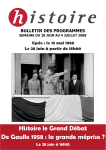
![広報いわふね 2011年6月号 [PDF:4888.0KB]](http://vs1.manualzilla.com/store/data/006609405_2-2a100fe8f0376ecfc986c01a8b463308-150x150.png)

